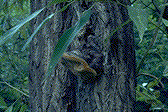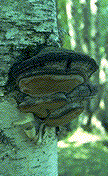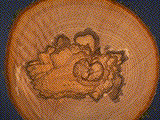Archived Content
Information identified as archived on the Web is for reference, research or recordkeeping purposes. It has not been altered or updated after the date of archiving. Web pages that are archived on the Web are not subject to the Government of Canada Web Standards. As per the Communications Policy of the Government of Canada, you can request alternate formats on the Contact Us page.
Hardwood Trunk Rot
Phellinus igniarius (L.:Fr.) Quél.
(= Fomes igniarius (L.:Fr.) J. Kickx. fil.)
Basidiomycotina, Aphyllophorales, Polyporaceae
Hosts: Phellinus igniarius is commonly found on many deciduous tree species. In B.C. it has been reported on maple, alder, arbutus, birch, apple, dogwood, cottonwood, locust, and willow. In other parts of North America it has also been found on beech, ash, walnut, cherry, plum, Douglas-fir, pear, oak, and elm.
Distribution: This fungus is widely distributed throughout the range of its hosts in B.C.
Identification: The fruiting bodies are perennial, hard, woody, and generally hoof-shaped, up to 11 cm high x 20 cm wide x 8 cm deep (Figs. 19a, 19b). The upper surface is deeply zoned, grey-black to black and roughened when old. The lower surface is brown and poroid; the pores are small and regular in outline. The context is rust-brown; old tubes are in distinct layers, and are filled with white mycelium that appears as white streaks. Fruiting bodies form on living and dead standing trees and on slash. The presence of a single fruiting body generally indicates a considerable volume of decay.
The early stage of the decay appears as a yellow-white zone in the heartwood, usually surrounded by a yellow-green to brown margin. In the advanced stage the soft yellow-white wood usually contains fine black zone lines running throughout; zone lines also usually surround the decay column (Fig. 19c). Decay symptoms are very similar to those of Phellinus tremulae.
Microscopic Characteristics: Pores circular, 5-6 per mm. Hyphae in the context of the fruiting body of two types: thick-walled, aseptate, turning brown in KOH; and thin-walled, hyaline, with occasional simple septa. Hymenial setae abundant to rare, 14-17 x 4-6 µm. Basidiospores broadly ovoid to subglobose, hyaline, smooth, thick-walled, IKI-, 5-6.5 x 4.5-6 µm. Growth in culture moderate, mat white, becoming yellow-brown, laccase positive. Stalpers: 1 3 4 (8) (9) (11) (12) (13) (14) 21 22 (23) (25) (26) 28 (30) (31) (34) 35 (37) (38) (46) 48 (51) 52 53 54 (55) 64 67 (80) 83 89.
Damage:Phellinus igniarius is a less aggressive pathogen than other species in the P. igniarius complex, but the fungus has an economic impact on host trees grown for timber, pulp, or in recreation sites.
Remarks: A number of similar fungi, including Phellinus laevigatus, P. nigricans, and P. tremulae, were once considered as part of the Phellinus igniarius complex, but are now recognized as distinct species. Since the symptoms produced by these fungi are similar, they are often, however, grouped together as the cause of hardwood white trunk rot.
References:
Gilbertson, R. L. and L. Ryvarden. 1987. North American Polypores. 2:576. Fungiflora, Oslo.
Niemlä, T. 1975. On Fennoscandian polypores. IV. Phellinus igniarius, P. nigricans, and P. populicola, n. sp. Ann. Bot. Fennici. 12:93-122.
Figures
Click on any image to see the full size version.
Press "Back" on your browser to return to this screen.

Figure 19a: Phellinus igniarius on willow.
 Figure 19b: Phellinus igniarius on birch.
Figure 19b: Phellinus igniarius on birch.
 Figure 19c: Decayed wood with zone lines in P. igniarius-infected mountain alder.
Figure 19c: Decayed wood with zone lines in P. igniarius-infected mountain alder.
 This Web page has been archived on the Web.
This Web page has been archived on the Web.